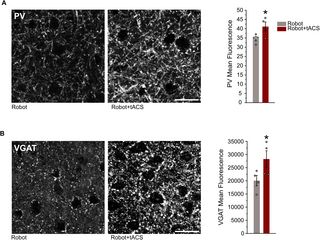Combining gamma neuromodulation and robotic rehabilitation after a stroke restores parvalbumin interneuron dynamics and improves motor recovery in #mice
by Livia Vignozzi, Francesca Macchi, Elena Montagni, Maria Pasquini, Alessandra Martello, Antea Minetti, Éléa Coulomb, Anna Letizia Allegra Mascaro, Silvestro Micera, Matteo Caleo, Cristina Spalletti
Stroke is a leading cause of long-term disability, frequently associated with persistent motor deficits. Gamma band oscillations, generated by synchronous discharge of parvalbumin-positive interneurons (PV-INs), are critically affected after stroke in humans and animals. Both gamma band and PV-INs play a key role in motor function, thus representing a promising target for poststroke neurorehabilitation. Noninvasive neuromodulatory approaches are considered a safe intervention and can be used for this purpose. Here, we present a novel, clinically relevant, noninvasive, and well-tolerated sub-acute treatment combining robotic rehabilitation with advanced neuromodulation techniques, validated in a mouse model of ischemic injury. During the sub-acute poststroke phase, we scored profound deficits in motor-related gamma band activity in the perilesional cortex. These deficits were accompanied by reduced PV-IN firing rates and increased functional connectivity, both at the perilesional and at the whole-cortex levels. Therefore, we tested the therapeutic potential of coupling robotic rehabilitation with optogenetic PV-IN-driven gamma band stimulation in a subacute poststroke phase during motor training to reinforce the efficacy of the treatment. Frequency-specific movement-related gamma band stimulation, when combined with physical training, significantly improved forelimb motor function. More importantly, by pairing robotic rehabilitation with a clinical-like noninvasive 40 Hz transcranial Alternating Current Stimulation, we achieved similar motor improvements mediated by the effective restoring of movement-related gamma band power, improvement of PV-IN maladaptive network dynamics, and increased PV-IN connections in premotor cortex. Our research introduces a new understanding of the role of parvalbumin-interneurons in poststroke impairment and recovery. These results highlight the synergistic potential of combining perilesional gamma band stimulation with robotic rehabilitation as a promising and realistic therapeutic approach for stroke patients.



















